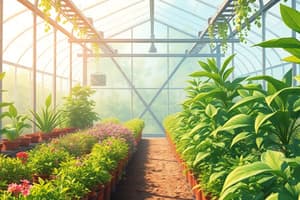Podcast
Questions and Answers
What is a consequence of high humidity in greenhouses?
What is a consequence of high humidity in greenhouses?
- Increase in crop yield
- Reduction of pests
- Improvement of plant growth
- Encouragement of disease development (correct)
Plants should be planted closely together to enhance air circulation.
Plants should be planted closely together to enhance air circulation.
False (B)
What is one method to reduce condensation in heated greenhouses?
What is one method to reduce condensation in heated greenhouses?
Late afternoon ventilations
_________ fans are used in greenhouses to circulate air and reduce humidity.
_________ fans are used in greenhouses to circulate air and reduce humidity.
Match each air circulation technique to its purpose:
Match each air circulation technique to its purpose:
Which of the following factors influences the orientation of a ridge vent in a greenhouse?
Which of the following factors influences the orientation of a ridge vent in a greenhouse?
Hanging baskets can improve humidity levels in crop canopies.
Hanging baskets can improve humidity levels in crop canopies.
Which of the following is a method to manipulate ventilation in high tunnels?
Which of the following is a method to manipulate ventilation in high tunnels?
Temperatures outside the normal range of growth do not affect plant stress levels.
Temperatures outside the normal range of growth do not affect plant stress levels.
What is a recommended solution for surface sterilizing tools and benches?
What is a recommended solution for surface sterilizing tools and benches?
Good air drainage and gentle __________ are important for selecting a site for new construction.
Good air drainage and gentle __________ are important for selecting a site for new construction.
Match each practice with its purpose in high tunnel management:
Match each practice with its purpose in high tunnel management:
What can puddling water on greenhouse floors lead to?
What can puddling water on greenhouse floors lead to?
What is one of the main factors contributing to increased disease incidence in greenhouses and high tunnels?
What is one of the main factors contributing to increased disease incidence in greenhouses and high tunnels?
Daytime relative humidity levels between 25% to 70% are usually supportive of pathogen growth.
Daytime relative humidity levels between 25% to 70% are usually supportive of pathogen growth.
Sweeping landscape cloth between cropping seasons is unnecessary and can be skipped.
Sweeping landscape cloth between cropping seasons is unnecessary and can be skipped.
Name one environmental factor that can stress plants in high tunnels.
Name one environmental factor that can stress plants in high tunnels.
What temperature and humidity conditions favor the development of plant pathogens?
What temperature and humidity conditions favor the development of plant pathogens?
To manage plant diseases, it is important to control __________ and __________ in greenhouse environments.
To manage plant diseases, it is important to control __________ and __________ in greenhouse environments.
Hoses left on the ground may become contaminated with __________.
Hoses left on the ground may become contaminated with __________.
Match the following terms with their correct descriptions related to greenhouse management:
Match the following terms with their correct descriptions related to greenhouse management:
Which ventilation strategy is most effective in managing high humidity levels in greenhouses?
Which ventilation strategy is most effective in managing high humidity levels in greenhouses?
Why is maintaining air circulation critical in a greenhouse?
Why is maintaining air circulation critical in a greenhouse?
High levels of leaf wetness contribute positively to plant growth in greenhouse settings.
High levels of leaf wetness contribute positively to plant growth in greenhouse settings.
Effective __________ strategies can help manage temperature and humidity, minimizing disease risk.
Effective __________ strategies can help manage temperature and humidity, minimizing disease risk.
Flashcards
Greenhouse ventilation
Greenhouse ventilation
The act of exchanging air inside a greenhouse with fresh outdoor air to lower relative humidity and reduce disease development.
High humidity effect
High humidity effect
High humidity promotes disease development in plants, such as powdery mildew and Botrytis gray mold.
Plant spacing
Plant spacing
Adequate plant spacing allows for proper air movement, drying of foliage, and easier application of treatments (like fungicides).
Microclimates
Microclimates
Signup and view all the flashcards
Exhaust fans
Exhaust fans
Signup and view all the flashcards
Condensation prevention
Condensation prevention
Signup and view all the flashcards
Ventilation in high humidity periods
Ventilation in high humidity periods
Signup and view all the flashcards
High tunnel ventilation
High tunnel ventilation
Signup and view all the flashcards
Ideal temperature for plant growth
Ideal temperature for plant growth
Signup and view all the flashcards
Why sterilize work surfaces?
Why sterilize work surfaces?
Signup and view all the flashcards
Bleach solution for sterilization
Bleach solution for sterilization
Signup and view all the flashcards
Landscape cloth cleaning
Landscape cloth cleaning
Signup and view all the flashcards
Plastic liner replacement
Plastic liner replacement
Signup and view all the flashcards
Puddling
Puddling
Signup and view all the flashcards
Hose contamination
Hose contamination
Signup and view all the flashcards
Plant debris removal
Plant debris removal
Signup and view all the flashcards
Ideal disease environment
Ideal disease environment
Signup and view all the flashcards
Key disease factors
Key disease factors
Signup and view all the flashcards
Disease management goal
Disease management goal
Signup and view all the flashcards
Humidity management
Humidity management
Signup and view all the flashcards
Optimal daytime humidity
Optimal daytime humidity
Signup and view all the flashcards
Ventilation
Ventilation
Signup and view all the flashcards
Continuous ventilation
Continuous ventilation
Signup and view all the flashcards
Study Notes
Managing Greenhouse & High Tunnel Environments
- Greenhouse and high tunnel environments are often warm and humid, which can promote disease development
- Key factors for disease development include high relative humidity (90% or more), free moisture (leaf wetness, wet soil), and warm temperatures
- Managing these environments is crucial for high-quality produce
- Managing relative humidity and temperature are key to minimizing disease spread
Managing Relative Humidity
- High relative humidity promotes many leaf, flower, and fruit diseases (including powdery mildew and gray mold)
- Daytime relative humidity between 25% and 70% often inhibits pathogen infection
- Humidity above 90% for prolonged periods can increase disease incidence
- Practices that manage humidity and temperature help mitigate this
Air Circulation
- Continuous air flow systems (fan-jet or horizontal) should operate in greenhouses for high humidity periods, particularly at night and during rainy days
- Exhaust fans can aid circulation when greenhouse sides are closed
- Exchange air inside greenhouses and tunnels with fresh outdoor air to reduce internal humidity
- Opening sidewalls and vents can help ventilate high tunnels.
Ventilation
- It's important to exchange air in greenhouses and high tunnels with fresh outdoor air to reduce internal humidity
- Ventilation in high tunnels can be manipulated by opening sidewalls, endwalls, and/or ridge vents.
Plant Spacing
- Closely-spaced plants and overlapping canopies create microclimates with higher humidity, which can be the first sites of disease development
- Adequate plant spacing promotes air movement, facilitating drying of foliage and making spray coverage easier
Water Management
- Water dripping on foliage can contribute to diseases. Drip irrigation is a better choice than overhead irrigation.
- Water only as needed, monitoring plants closely for variations in light, temperature, and humidity.
- Consider plant groupings for consistent water needs.
Sanitation
- Disease-causing pathogens spread via used pots, dirty tools, work surfaces, and contaminated hoses
- Regularly sterilize benches, tools, and work surfaces with a dilute bleach solution or commercial disinfectant.
- Remove diseased plant material immediately and bag (don't compost).
- Clean-up plant debris on benches, ground beds, and walkways, preventing further pathogen spread.
Soil Management
- Commercial, pathogen-free growing media are ideal for commercial production in flats and pots
- Ensure soil doesn't become excessively wet and avoid contact with natural soil
- Rotate crops and soil beds to prevent soilborne pathogen buildup
- If using natural soil, follow recommendations for crop rotation and soil maintenance to minimize pathogen buildup.
Other Important Considerations
- Tobacco mosaic virus (TMV) is spread physically through contact; wash hands thoroughly after tobacco product use.
- Avoid bringing soil from outdoors into greenhouses to prevent soilborne pathogen introduction.
- Avoid excessively wet conditions as these can increase humidity and pathogen growth.
Studying That Suits You
Use AI to generate personalized quizzes and flashcards to suit your learning preferences.
Related Documents
Description
This quiz focuses on the management of greenhouse and high tunnel environments, emphasizing the control of humidity and temperature to prevent disease. It covers key factors affecting disease spread and the importance of air circulation in maintaining optimal conditions for high-quality produce.




